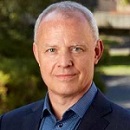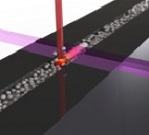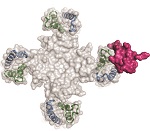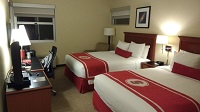Vol. 20, No. 4 - Nov / Dec 2019
View the Archives

From the Director
With the recent start of the current user run and the approaching holidays, I want to extend gratitude to our staff and user community for all you do to make SSRL a safe and successful place for great science. I look forward to working with you to explore new opportunities in the coming year, and I welcome your input to keep SSRL at the technological forefront. Happy Holidays! Science Highlights
Direct Imaging of Metal Additive Manufacturing Processes – Contact: Johanna Nelson Weker, SSRL 3D printing is revolutionizing the manufacture of products, promising fast and inexpensive ways to make quick prototypes, small batch parts, and unique pieces exactly to specifications. The uses for 3D printed metal range from specialized car parts to custom medical prosthetics. While the potential applications are many, there are limitations due to variable quality and strength of the products. To improve these materials, the science of the manufacturing processes needs to be better understood. Laser powder bed fusion (LPBF) additive manufacturing is a 3D printing process where a three dimensional part is built layer by layer. Read more...
A Spider Toxin Catches a Sodium Channel Involved in Pain Perception in Action – Contact: Jian Payandeh, Genentech Nerve, muscle, and heart cells are activated by the influx of sodium ions into the cells causing an increase in positive charge inside cells. In a carefully regulated system, sodium passes across cell membranes via a variety of sodium ion channels, which open during activation and close when not active. Nav1.7 is a type of sodium channel that has an important role in pain sensation. Dysfunction of Nav1.7 is implicated diseases that involve the hypersensitivity or hyposensitivity to pain. Due to this role, Nav1.7 is a potential target for therapies that address chronic pain. Read more... SSRL-Related Science in the NewsStanford Researchers Create New Catalyst that can Turn Carbon Dioxide into Fuels Excerpt from Stanford News article by Andrew Myers Imagine grabbing carbon dioxide from car exhaust pipes and other sources and turning this main greenhouse gas into fuels like natural gas or propane: a sustainability dream come true. Several recent studies have shown some success in this conversion, but a novel approach from Stanford University scientists yields four times more ethane, propane and butane than existing methods that use similar processes. While not a climate cure-all, the advance could significantly reduce the near-term impact on global warming. Previous efforts to convert CO2 to fuel involved a two-step process. The first step reduces CO2 to carbon monoxide, then the second combines the CO with hydrogen to make hydrocarbon fuels. The simplest of these fuels is methane, but other fuels that can be produced include ethane, propane and butane. Matteo Cargnello, Assistant Professor of Chemical Engineering at Stanford, thought completing both steps in a single reaction would be much more efficient, and set about creating a new catalyst that could simultaneously strip an oxygen molecule off of CO2 and combine it with hydrogen. “This nugget of ruthenium sits at the core and is encapsulated in an outer sheath of iron,” said Aisulu Aitbekova, a doctoral candidate in Cargnello’s lab and lead author of the paper. “This structure activates hydrocarbon formation from CO2. It improves the process start to finish.” The team did not set out to create this core-shell structure but discovered it through collaboration with SSRL distinguished staff scientist Simon Bare and his group including Adam Hoffman and Alexey Boubnov. SSRL's x-ray characterization technologies on Beam Lines 9-3, 4-1 and 2-2 helped the researchers visualize and examine the structure of their new catalyst. Without this collaboration, Cargnello said they would not have discovered the optimal structure. Read more... J. Am. Chem. Soc. 2018, 140, 13736-13745, doi: 10.1021/jacs.8b07615 Taking a Closer Look at the Causes of a Stroke What if a blood test could indicate that a patient was going to have a stroke? Vascular surgeon and SSRL user Dr. David Kopriva (MD) is working towards that goal by determining how plaque in carotid arteries are activated to cause a stroke. Kopriva is a Regina-based faculty member in the Department of Surgery in the College of Medicine. Watch the video Request for Publications Related to SSRL Beam Time Publications are an essential metric of how productively SSRL beam time has been utilized. As with other Department of Energy light sources we have an upcoming triennial review in the spring. It will be especially important to have current records of 2017-2019 publications related to work done at SSRL. Please take a few minutes to review our publications database to confirm that your most recent SSRL-related publications are included and submit if they are not. After data have been collected, analyzed and prepared for presentation or publication, remember to indicate the SSRL beam lines used, acknowledge us, and inform us of your peer-reviewed journal papers, book chapters, conference proceedings, theses, and patents. Acknowledgement templates are provided on our website. Thank you in advance for your assistance and continued support of SSRL. Events
AnnouncementsSLAC Guest House Update: Limited Availability during Renovations Occurring January–March 2020
While the good news is that the Stanford Guest House plans to begin room renovations during the holiday shut down, the bad news is that renovations are expected to continue through March. They will start by renovating rooms on the third floor which may mean construction noise and difficulty reserving limited rooms during this period. So, if you have beam time or plan to visit for other activities, don’t delay – reserve today! Guest House User Reservation website User Research AdministrationThe FY2020 SPEAR3 operations schedule is posted for users to review planned operations, maintenance/accelerator physics, and holidays for the current year. The FY2020 user run will continue through August 10, 2020, with down time scheduled December 20, 2019 – January 12, 2020 (Winter Break), and April 6–14, 2020 (Spring Break). Beam Time Requests
Proposal Deadlines
Submit beam time requests and proposals through the User Portal. _____________________________________________________________________ The Stanford Synchrotron Radiation Lightsource (SSRL) is a third-generation light source producing extremely bright x-rays for basic and applied research. SSRL attracts and supports scientists from around the world who use its state-of-the-art capabilities to make discoveries that benefit society. SSRL, a U.S. DOE Office of Science national user facility, is a Directorate of SLAC National Accelerator Laboratory, operated by Stanford University for the U.S. Department of Energy Office of Science. The SSRL Structural Molecular Biology Program is supported by the DOE Office of Biological and Environmental Research, and by the National Institutes of Health, National Institute of General Medical Sciences. For more information about SSRL science, operations and schedules, visit http://www-ssrl.slac.stanford.edu. To unsubscribe from SSRL Headlines, just send an e-mail to listserv@slac.stanford.edu with "signoff ssrl-headlines" in the body. To subscribe, send an e-mail to listserv@slac.stanford.edu with "subscribe ssrl-headlines" in the body. Questions? Comments? Contact Lisa Dunn
|




